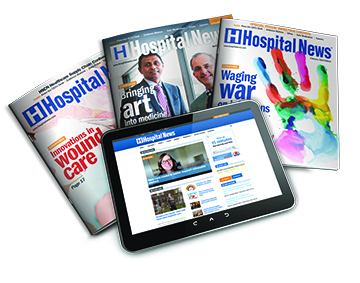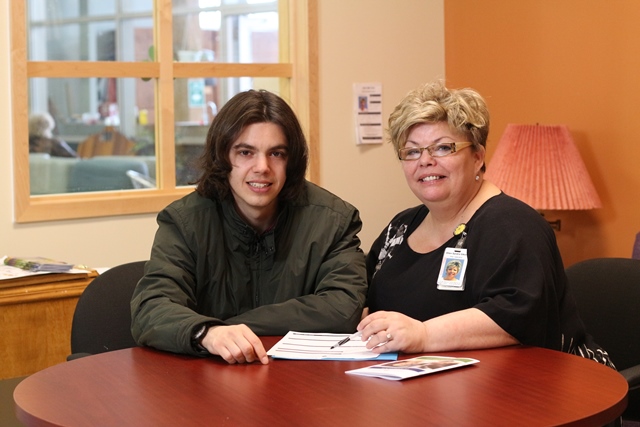The voice of the #mental health patient at the #North Bay Regional Health Centre (NBRHC) is being heard now more than ever before, thanks to the #One Patient One Plan (OPOP) program. It has changed the way staff and patients interact. The decision to create the OPOP program came about in response to the changes in mental health services across Ontario, with more focus on the recovery model instead of the traditional custodial model. There has been an increase in mental health patients being re-integrated into their communities with supports, rather than having them remain in hospital, sometimes for years. By moving away from custodial care, we must ensure that people with mental illness are capable of partnering in their care and ultimately living in the community. Through OPOP the hospital puts patients first, listening to their needs and thoughts, and helping them move on towards independence.
“When I think of self directed, person-centered, empowered, respectful care, One Patient One Plan does all of those things. It really helps to instill hope for our patients and their families that recovery is real and recovery is possible,” says Laurie Wardell, a Director of Mental Health at NBRHC.
OPOP moves past the traditional way of patient planning, where many patients were placed in the same routine with the same expectations for everyone. One Patient One Plan provides a framework of how members of the clinical team can meet regularly with each patient, and create individual goals with the patient’s input.
MORE: IMPROVING CARE FOR PEOPLE EXPERIENCING MENTAL HEALTH CRISES
“Years ago, we implemented the recovery philosophy and it was a fantastic improvement and quite a dramatic departure from the custodial type of era,” says Helene Philbin Wilkinson, a Director of Mental Health at NBRHC. “One Patient One Plan helps us drill down even further in terms of the principle of being person centered and it really elevates the patient as a bit of the driver, in terms of how they see themselves moving through the mental health system.
Instead of meeting in large groups and discussing the patient without the patient present, clinical staff at NBRHC now meets regularly in small mini teams with the patient and their families. They create goals together based on the patient’s personal recovery needs, and also review the clinical picture of why they have been admitted to the hospital. The patient is at the table, included in frank, honest discussions about the reason for admission, what to expect during the hospital stay, and when they may be discharged.
As soon as a patient enters the hospital, staff connects with the community partners in order to paint the broad picture for the patient, so that he or she will look at their treatment with a view to being discharged. Gone are the days of being admitted to the hospital with the idea that the patient would remain there indefinitely with no set plan to return to the community. Through OPOP the staff keeps close tabs on each patient as his or her goal is achieved. This is pointed out to the patient who may not be aware of what they have accomplished. Gradually the patient’s self esteem is renewed, and reliance on staff is reduced. As goals are met, staff fades into the background and the patient becomes more self sustaining. Under OPOP, staff is no longer seen as the ‘care taker’, but more as the facilitator toward independence.
MORE: LET’S RID THE WORLD OF SUICIDE
Goals can be as big as wanting to return to school or as simple as showering and dressing properly. Dr. Susan Johnston says upon arrival at the hospital one patient was feeling negative and not interacting with the team on any goals. However, following his OPOP team meetings this patient began to open up and speak and even laugh. He started to put his plan into action, achieving some of his goals.
“That’s the wonderful part about OPOP,” says Dr. Johnston. “You get the patient’s feedback on how they think they are doing and we (staff) respond with how we think they are doing. With this particular patient we discussed withdrawing his reminders around showering, once he had achieved that goal, and he asked ‘why can’t I bring them home with me so that I can remember?’ That was an ah ha moment because it was not often that we were getting direct feedback from the individual that it matters most to – about what they think will help them when they go home.”
Patients say One Patient One Plan is making a difference. They like going to their regular ‘check-in’ and getting the personal attention. Louise says, “The smaller one-on-one is a good way to deal with patients who have anxiety and have a hard time opening up.” Mary Jane says, “All in all I like it, and I think the healthier the patient gets, the more they realize that it’s important.”
MORE: PREVENTING INJECTION DRUG USE
Family members say they are very appreciative to be involved in the OPOP meetings. They say it’s much less intimidating to meet with their loved one and two or three staff, rather than facing a team of fifteen or so health care professionals.
Staff is also noticing the benefits of OPOP. Registered Nurse, Brad McBlaine, says, “The staff has done an amazing job at adapting to what is essentially quite a different process from what we had. I think that a lot of us feel that this is the way we were meant to interact with our patients.”
As a former patient and current peer support worker in the hospital Drop in Centre, Ron Brusseau has been observing the OPOP process with enthusiasm. “It’s interesting to see,” he says with a big grin. “The patients have been coming in, grabbing a quick coffee and saying “well I’ve got to go, I’m going to my OPOP” and then they come back later and they’re all talking about one another’s goals and who’s getting discharged next and where they’re going. They’re celebrating with handshakes and hugs. It’s really cool to see that they’re talking about it like that, saying: ‘So what are your three goals? Who do you have for support and are you getting a job, or going to school?’ It’s all part of the OPOP experience!”




